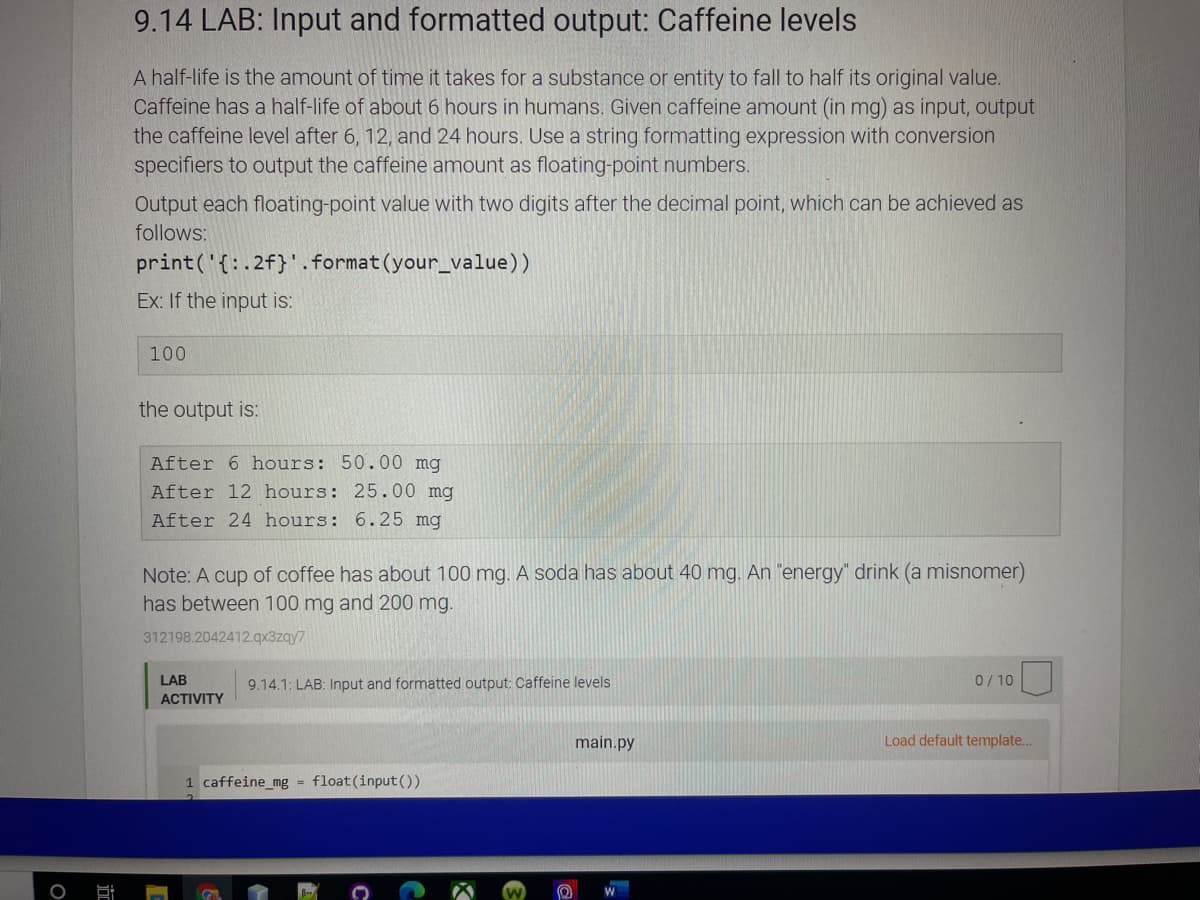A half-life is the amount of time it takes for a substance or entity to fall to half its original value. Caffeine has a half-life of about 6 hours in humans. Given caffeine amount (in mg) as input, output the caffeine level after 6, 12, and 24 hours. Use a string formatting expression with conversion specifiers to output the caffeine amount as floating-point numbers. Output each floating-point value with two digits after the decimal point, which can be achieved as follows: print('{:.2f}'. format(your_value)) Ex: If the input is: 100 the output is: After 6 hours: 50. 00 mg After 12 hours: 25.00 mg After 24 hours: 6.25 mg Note: A cup of coffee has about 100 mg. A soda has about 40 mg. An "energy" drink (a misnomer) has between 100 mg and 200 mg. 312198.2042412.qx3zgy7 LAB 9.14.1: LAB: Input and formatted output: Caffeine levels 0/10 ACTIVITY main.py Load default template... 1 caffeine_mg = float(input())
A half-life is the amount of time it takes for a substance or entity to fall to half its original value. Caffeine has a half-life of about 6 hours in humans. Given caffeine amount (in mg) as input, output the caffeine level after 6, 12, and 24 hours. Use a string formatting expression with conversion specifiers to output the caffeine amount as floating-point numbers. Output each floating-point value with two digits after the decimal point, which can be achieved as follows: print('{:.2f}'. format(your_value)) Ex: If the input is: 100 the output is: After 6 hours: 50. 00 mg After 12 hours: 25.00 mg After 24 hours: 6.25 mg Note: A cup of coffee has about 100 mg. A soda has about 40 mg. An "energy" drink (a misnomer) has between 100 mg and 200 mg. 312198.2042412.qx3zgy7 LAB 9.14.1: LAB: Input and formatted output: Caffeine levels 0/10 ACTIVITY main.py Load default template... 1 caffeine_mg = float(input())
C++ Programming: From Problem Analysis to Program Design
8th Edition
ISBN:9781337102087
Author:D. S. Malik
Publisher:D. S. Malik
Chapter2: Basic Elements Of C++
Section: Chapter Questions
Problem 8PE
Related questions
Question
Use python to solve this. Thanks

Transcribed Image Text:9.14 LAB: Input and formatted output: Caffeine levels
A half-life is the amount of time it takes for a substance or entity to fall to half its original value.
Caffeine has a half-life of about 6 hours in humans. Given caffeine amount (in mg) as input, output
the caffeine level after 6, 12, and 24 hours. Use a string formatting expression with conversion
specifiers to output the caffeine amount as floating-point numbers.
Output each floating-point value with two digits after the decimal point, which can be achieved as
follows:
print('{:.2f}'.format(your_value))
Ex: If the input is:
100
the output is:
After 6 hours: 50.00 mg
After 12 hours: 25.00 mg
After 24 hours: 6.25 mg
Note: A cup of coffee has about 100 mg. A soda has about 40 mg. An "energy" drink (a misnomer)
has between 100 mg and 200 mg.
312198.2042412.qx3zqy7
LAB
9.14.1: LAB: Input and formatted output: Caffeine levels
0/ 10
ACTIVITY
main.py
Load default template...
1 caffeine_mg = float(input())
Expert Solution
This question has been solved!
Explore an expertly crafted, step-by-step solution for a thorough understanding of key concepts.
This is a popular solution!
Trending now
This is a popular solution!
Step by step
Solved in 2 steps with 1 images

Recommended textbooks for you

C++ Programming: From Problem Analysis to Program…
Computer Science
ISBN:
9781337102087
Author:
D. S. Malik
Publisher:
Cengage Learning

C++ Programming: From Problem Analysis to Program…
Computer Science
ISBN:
9781337102087
Author:
D. S. Malik
Publisher:
Cengage Learning